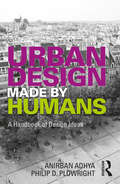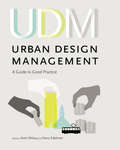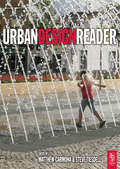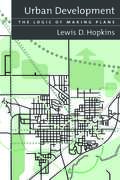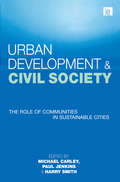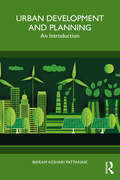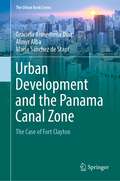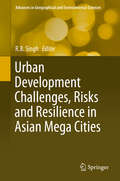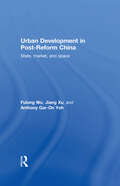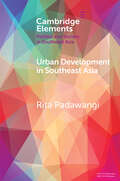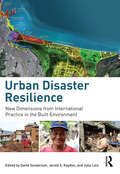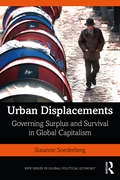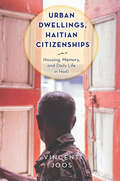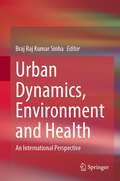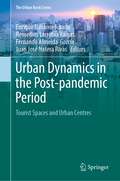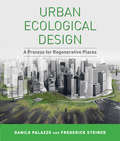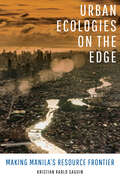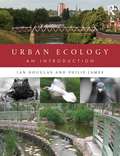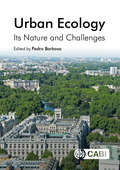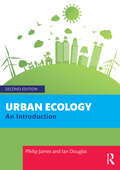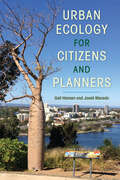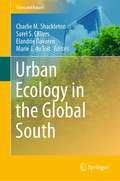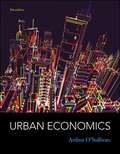- Table View
- List View
Urban Design Made by Humans: A Handbook of Design Ideas
by Anirban Adhya Philip D. PlowrightThe design of urban environments is complex and involves diverse needs, organisations, professions, authorities, and communities. It requires relationships to be constructed and sustained between infrastructure, resources, and populations across multiple scales. This can be quite daunting. However, at the core of urban design is a simple idea—our urban spaces are designed to allow people and communities to thrive. For that reason, a good starting point for urban designers is to focus on the way people think when engaging our built environment. This thinking is embodied, developed through the interactions between our mind, body, and the environment around us. These embodied concepts are central to how we see the world, how we move and gather, and how we interact with others. They are also the same ideas we use to design our environments and cities. Urban Design Made by Humans is a reference book that presents 56 concepts, notions, ideas, and agreements fundamental to the design and interpretation of our human settlements. The ideas here parallel those found in Making Architecture Through Being Human but extends them into urban environments. Urban Design Made by Humans distinctly highlights priorities in urban design in how we produce meaningful environments catering to wider groups of people. Each idea is isolated for clarity with short and concise definitions, examples, and illustrations. They are organised in five sections of increasing complexity. Taken as a whole, the entries frame the priorities and values of urban design while also being instances of a larger system of human thinking.
Urban Design Management: A Guide to Good Practice
by Antti Ahlava Harry EdelmanThis is an introduction to the secrets of Urban Design Management (UDM). The book examines the roles of the players involved in land-use projects and describes good collaborative methods of practice in project-based urban design and planning, putting emphasis on the creative co-operative skills and the wide knowledge of the participants in a working group. The role of the architect is examined in relation to design, planning and project management with particular emphasis on collaboration and negotiation skills. Specific issues considered include: The make-up of a good project team Ways to make the project team function together Objectives and benefits of project-orientated planning The need to take local characteristics into account in project-orientated planning The preparation required for a co-operative planning process and how initial information can be collected and used How to define project content, and outlining the project itself Partner-specific strategies Urban Design Management contains international examples and many diagrams and photographs, making it a useful and accessible guide for all built environment professionals working in the public realm and those studying architecture, urban design and planning at a graduate level.
Urban Design Reader
by Steve Tiesdell Matthew CarmonaEssential reading for students and practitioners of urban design, this collection of essays introduces the 6 dimensions of urban design through a range of the most important classic and contemporary key texts. Urban design as a form of place making has become an increasingly significant area of academic endeavour, of public policy and professional practice. Compiled by the authors of the best selling Public Places Urban Spaces, this indispensable guide includes all the crucial definitions and various understandings of the subject, as well as a practical look at how to implement urban design that readers will need to refer to time and time again. Uniquely, the selections of essays that include the works of Gehl, Jacobs, and Cullen, are presented substantially in their original form, and the truly accessible dip-in-and-out format will enable readers to form a deeper, practical understanding of urban design.
Urban Development: The Logic Of Making Plans
by Lewis D. HopkinsWith increased awareness of the role of plans in shaping urban and suburban landscapes has come increased criticism of planners and the planning profession. Developers, politicians, and citizens alike blame "poor planning" for a host of community ills. But what are plans really supposed to do? How do they work? What problems can they successfully address, and what is beyond their scope? In Urban Development, leading planning scholar Lewis Hopkins tackles these thorny issues as he explains the logic of plans for urban development and justifies prescriptions about when and how to make them. He explores the concepts behind plans, some that are widely accepted but seldom examined, and others that modify conventional wisdom about the use and usefulness of plans. The book: places the role of plans and planners within the complex system of urban development offers examples from the history of plans and planning discusses when plans should be made (and when they should not be made) gives a realistic idea of what can be expected from plans examines ways of gauging the success or failure of plansThe author supports his explanations with graphics, case examples, and hypothetical illustrations that enliven, clarify, and make concrete the discussions of how decisions about plans are and should be made.Urban Development will give all those involved with planning human settlements a more thorough understanding of why and how plans are made, enabling them to make better choices about using and making plans. It is an important contribution that will be essential for students and faculty in planning theory, land use planning, and planning project courses.
Urban Development and Civil Society: The Role of Communities in Sustainable Cities
by Harry Smith Michael CarleyThe world's population is rapidly urbanizing but the affluence and development often associated with cities are far from equitably or sustainably distributed. Where it was once taken for granted that responsibility for urban development lay with the state, increasingly the emphasis has shifted to market-driven and public-private sector initiatives, which can marginalize the intended beneficiaries - the urban poor - from decision making and implementation. This text outlines the essential conditions for effective urban planning and management by placing bottom-up community initiatives at the heart of the push for equitable and sustainable development in cities. Crucially, the state must engage with both the market and civil society in pursuit of sustainable cities. Presenting a wide-ranging selection of case studies in rapidly urbanizing and transitional countries, from the poorest parts of Africa and Asia to the relatively developed United Kingdom, the authors describe and analyze innovations in how globally disadvantaged urban communities can be engaged in improving their living environments.
Urban Development and Planning: An Introduction
by Bikram PattanaikThis book details the most contemporary concerns related to urban development, governance, and planning, as well as the challenges to urban administration. It analyses the policies and programmes adopted by both high-income and lower-middle-income countries to achieve sustainable urbanization and their application and treatment to help students get a holistic, practical perspective of the issues at hand.This volume elucidates urban development theories and approaches, coupled with urban planning, local government finance, urban management, and urban governance. It also discusses urban issues and challenges such as education, health, waste management, land use planning, housing, and transport. Critical concerns related to urban water bodies, open spaces, urban heritage and smart cities, and urban future are similarly addressed.This book will be useful to students, researchers, and teachers of urban planning and architecture, urban sociology, economics, geography, environmental science, and public administration. It shall also be useful to NGOs, parastatal bodies, and trainers of urban planning and development. Planners, policymakers, functionaries, and elected representatives of urban local bodies may also use this book as a capacity-building instrument.
Urban Development and the Panama Canal Zone: The Case of Fort Clayton (The Urban Book Series)
by Graciela Arosemena Díaz Almyr Alba María Sánchez StapfThe construction of the Panama Canal at the beginning of the twentieth century created an enclave that ran parallel to the interoceanic waterway, controlled by the US government: the Canal Zone. This book aims to understand the implications that Panama Canal Zone urban planning had on human health, natural resources, and biodiversity through the study case of Fort Clayton, highlighting how the sanitary concerns shaped building regulations and the urban landscape of towns.This book highlights the role of North American entomologists and health workers in developing control strategies for diseases transmitted by mosquitoes and how mosquito’s ecology determined building regulations that shaped the image of the Canal Zone towns. On the other hand, the book determines the environmental assessment of Fort Clayton, determined by the two fundamental aspects that set on the environmental impact of an urban settlement. The first one is the suitability of the site's location. The second is the urban structure of the adopted city model and its impact on the connectivity of the surrounding forests during the twentieth century.This text is aimed at both undergraduate and postgraduate students, architects, urban planners, historians, and environmental science professionals.
Urban Development Challenges, Risks and Resilience in Asian Mega Cities
by R. B. SinghIn this book, an interdisciplinary research group of faculty members, researchers, professionals, and planners contributed to an understanding of the dynamics and dimensions of emerging challenges and risks in megacities in the rapidly changing urban environments in Asia and examined emerging resilience themes from the point of view of sustainability and public policy. The world's urban population in 2009 was approximately 3. 4 billion and Asia's urban population was about 1. 72 billion. Between 2010 and 2020, 411 million people will be added to Asian cities (60 % of the growth in the world's urban population). By 2020, of the world's urban population of 4. 2 billion, approximately 2. 2 billion will be in Asia. China and India will contribute 31. 3 % of the total world urban population by 2025. Developing Asia's projected global share of CO2 emissions for energy consumption will increase from 30 % in 2006 to 43 % by 2030. City regions serve as magnets for people, enterprise, and culture, but with urbanisation , the worst form of visible poverty becomes prominent. The Asian region, with a slum population of an estimated 505. 5 million people, remains host to over half of the world's slum population . The book provides information on a comprehensive range of environmental threats faced by the inhabitants of megacities. It also offers a wide and multidisciplinary group of case studies from rapidly growing megacities (with populations of more than 5 million) from developed and developing countries of Asia.
Urban Development in China under the Institution of Land Rights (Routledge Advances in Regional Economics, Science and Policy)
by Jieming ZhuHow have the development and redevelopment of China’s cities since the early 1950s transformed the settlements and fortunes of a fifth of the world’s population? Rapid urbanization since the 1980s has changed the nation from a rural society to an urban one, marking it as one of the most significant transformations in history. As a country with severe land scarcity, land resources are intensively contested for during urbanization under the new regime of marketization. This book focuses on the impact of the institution of land rights that have transitioned from private ownership to socialist state ownership, and subsequently to public land leasing in the urban domain, and to collective ownership in rural areas. In the context of defining the relationship between the state and the market, the gradualist transition of land rights gives rise to intriguing processes of place-making. The elaboration of these processes will engage several revealing conceptual notions: land as a means of production, land commodification, ambiguous land rights, incomplete land rights, trading land use rights for land development rights, institutional uncertainty, land rent seeking and dissipating, local developmental state, danwei-enterprises, and more. The newly created landed interests are embedded intricately within the urban spatial structure. This book would especially be of interest to scholars interested in developmental economics, urban planning, geography, public policies, public management, and sociology, and also practitioners focusing on development and planning.
Urban Development in Post-Reform China: State, Market, and Space
by Fulong Wu Jiang Xu Anthony Gar-On YehRadically reoriented under market reform, Chinese cities present both the landscapes of the First and Third World, and are increasingly playing a critical role in the country’s economic development. Yet, radical marketization co-exists with the ever-presence of state control. Exploring the interaction of China’s market development, state regulation and the resulting transformation and creation of new urban spaces, this innovative, key book provides the first integrated treatment of China’s urban development in the dynamic market transition. Focusing on land and housing development, the authors, all renowned authorities in this field, show how the market has been ‘created’ under post-reform urban conditions, and examine ‘the state in action’, highlighting how changing urban governance towards local entrepreneurial state facilitates market formation. A significant, original contribution, they highlight the key actors and their institutional contexts. China has been very successful in using urban land development as an economic growth engine, and here the authors investigate complex interactions between the market and state in creating this new urbanism. Taking a unique perspective, they marshal original ideas and empirical work based on field studies and collaborative work with colleagues in China.
Urban Development in Southeast Asia (Elements in Politics and Society in Southeast Asia)
by Rita PadawangiUrbanization as a process is rife with inequality, in Southeast Asia as anywhere else, but resistance and contestation persist on the ground. In this element, the author sets out to achieve three goals: 1) to examine the political nature of urban development; 2) to scrutinize the implications of power inequality in urban development discussions; and 3) to highlight topical and methodological contributions to urban studies from Southeast Asia. The key to a robust understanding is groundedness: knowledge about the everyday realities of urban life that are hard to see on the surface but dominate how the city functions, with particular attention to human agency and the political life of marginalized groups. Ignoring politics in research on urbanization essentially perpetuates the power inequities in urban development; this element thus focuses not just on Southeast Asian cities and urbanization per se, but also on critical perspectives on patterns and processes in their development.
Urban Development in the Muslim World
by HOOSHANG AMIRAHMADI and SALAH S. EL-SHAKHSWar and revolution have focused the world's attention on the Middle East. Despite the headlines, the editors of this book state, the economic, political, and cultural aspects of urban life in the Muslim world are hardly known to us. Contributors to this volume explore urban problems, urban development, and the practice of urban planning in the Muslim world.In both comprehensive analyses and detailed case studies, the contributors address the basic dilemma of development planning: how to integrate the force of tradition with the demands of modernity. Specifically, some of the topics covered include the examination of the idea of a uniquely Islamic city; the influence of Islam on the medinas of Tunisia and Morocco and on the development of Mecca and Delhi; and reconciling tradition and modernism in Tehran.Also covered are the comparative development of Sana'a and Cairo; the influence of oil on urbanization in the Persian Gulf; urban growth in Syria; and an overview of urban planning in the Arab world. This compendium is essential for specialists and students of the region, for international planning and development practitioners, and for those seeking insight into the complexities of this important but arguably least understood region of the world.
Urban Disaster Resilience: New Dimensions from International Practice in the Built Environment
by David Sanderson Jerold S. Kayden Julia LeisAccelerating urbanization worldwide means more urban-centered disasters. Floods, earthquakes, storms and conflicts affecting densely populated areas produce significant losses in lives, livelihoods and the built environment, especially in comparison to rural areas. Poor urban dwellers, almost always the most vulnerable, too often bear the brunt. Aid agencies and urban professionals have been slowly adapting to these new conditions, but older models and practices hinder the most effective engagements. Drawing directly from the experiences of urban disasters in the Philippines, Chile, India, Thailand, Iraq, Haiti and Nepal, among other countries, Urban Disaster Resilience brings to light new collaborations and techniques for addressing the challenges of urban disasters in the coming years. Chapters range from country-specific case studies to more synthetic frameworks in order to promote innovative thinking and practical solutions. Edited by David Sanderson, Jerold S. Kayden and Julia Leis, this book is a crucial read for humanitarian and disaster specialists, urban planners and designers, architects, landscape architects, housing and economic development professionals, real estate developers, private business managers and students interested in the subject, whether based in non-governmental organizations, local, state or national governments, international agencies, private firms, or the academy.
Urban Displacements: Governing Surplus and Survival in Global Capitalism (RIPE Series in Global Political Economy)
by Susanne SoederbergWith an eye to further our understanding of everyday life in global capitalism, Urban Displacements provides the first systemic critical political economy analysis of low-income rental housing and social dislocations, combining both theoretical advancements and detailed empirical studies, centering on Berlin, Dublin and Vienna.Soederberg pushes beyond dominant debates by treating low-rent housing as a unique commodity that provides a necessary place for the societal reproduction of labour power whilst being integrated into the global dynamics of capitalism. She argues that historical and geographical configurations of monetized governance, including landlords, employers and inter-scalar state practices, have served to reproduce urban displacements and obfuscate their gendered, class and racialized underpinnings. The outcome is the everyday facilitation and normalization of urban poverty and social marginalization on one side, and capital accumulation on the other.Building on Soederberg’s previous book Debtfare States and the Poverty Industry, this accessible and interdisciplinary text will be useful to academics and students in political science, sociology, geography, urban studies, labour studies, European studies and gender studies.
Urban Dwellings, Haitian Citizenships: Housing, Memory, and Daily Life in Haiti (Critical Caribbean Studies)
by Vincent JoosUrban Dwellings, Haitian Citizenships explores the failed international reconstruction of Port-au-Prince after the devastating 2010 earthquake. It describes the failures of international aid in Haiti while it analyzes examples of Haitian-based reconstruction and economic practices. By interrogating the relationship between indigenous uses of the cityscape and the urbanization of the countryside within a framework that centers on the violence of urban planning, the book shows that the forms of economic development promoted by international agencies institutionalize impermanence and instability. Conversely, it shows how everyday Haitians use and transform the city to create spaces of belonging and forms of citizenship anchored in a long history of resistance to extractive economies. Taking readers into the remnants of failed industrial projects in Haitian provinces and into the streets, rubble, and homes of Port-au-Prince, this book reflects on the possibilities and meanings of dwelling in post-disaster urban landscapes.
Urban Dynamics, Environment and Health: An International Perspective
by Braj Raj Kumar SinhaThe comprehensive volume focuses on spatial, temporal, conceptual and empirical approaches to various elements of urban dynamics, environment and urban health. It demonstrates a multidisciplinary account of the significant dimensions of urbanization and urban life. Chapters by leading international experts are presented in sections on urban dynamics, Urban Environmental Issues, Urban Health Problems and Urban Development, Planning and Policies. Each chapter provides a breadth of information on conceptual and empirical studies of urban issues. It enables the readers to understand the interconnections of various vital elements of each urban-related topical issue locally, regionally and globally. Extensive maps, charts, diagrams and tables as cartographic tools facilitate the reader’s understanding. It also outlines an action plan for policy program change in both the developed and less developed countries toward sustainable urban development and environment for better health, prosperity and quality of life of the present and future urban population. It is an indispensable reference for students, research scholars of geography and environmental, medical, and social sciences at undergraduate and postgraduate levels.
Urban Dynamics in the Post-pandemic Period: Tourist Spaces and Urban Centres (The Urban Book Series)
by Enrique Navarro-Jurado Remedios Larrubia Vargas Fernando Almeida-García Juan José Natera RivasThis book offers a unique perspective on urban processes affecting tourist spaces and city centres. Economic, social and environmental uncertainty has been commonplace since March 2019, when mobility slowed down across the globe. The COVID-19 pandemic accelerated trends that have been investigated in urban space for years. The incorporation of technologies, the expansion of tourism and the introduction of policies that in part want to advance sustainability are generating processes of reorganisation of territories that are driving changes. These changes will affect models of city, urbanism and society.This publication is directed to a wide spectrum of people interested in urban processes, tourism and social change in the context of the Post-Pandemic Covid-19. In particular, the book is aimed at researchers, undergraduate and postgraduate students, consultants, public administrations and the public interested in the recent challenges that are affecting developed and developing societies.
Urban Ecological Design: A Process for Regenerative Places
by Danilo Palazzo Frederick R. SteinerThis trailblazing book outlines an interdisciplinary "process model" for urban design that has been developed and tested over time. Its goal is not to explain how to design a specific city precinct or public space, but to describe useful steps to approach the transformation of urban spaces. Urban Ecological Design illustrates the different stages in which the process is organized, using theories, techniques, images, and case studies. In essence, it presents a "how-to" method to transform the urban landscape that is thoroughly informed by theory and practice. The authors note that urban design is viewed as an interface between different disciplines. They describe the field as "peacefully overrun, invaded, and occupied" by city planners, architects, engineers, and landscape architects (with developers and politicians frequently joining in). They suggest that environmental concerns demand the consideration of ecology and sustainability issues in urban design. It is, after all, the urban designer who helps to orchestrate human relationships with other living organisms in the built environment. The overall objective of the book is to reinforce the role of the urban designer as an honest broker and promoter of design processes and as an active agent of social creativity in the production of the public realm.
Urban Ecologies on the Edge: Making Manila's Resource Frontier
by Kristian Karlo SaguinLaguna Lake, the largest lake in the Philippines, supplies Manila's dense urban region with fish and water while operating as a sink for its stormflows and wastes. Transforming the lake to deliver these multiple urban ecological functions, however, has generated resource conflicts and contradictions that unfold unevenly across space. In Urban Ecologies on the Edge, Kristian Karlo Saguin tracks the politics of resource flows and unpacks the narratives of Laguna Lake as Manila's resource frontier. Provisioning the city and keeping it safe from floods are both frontier-making processes that bring together contested socioecological imaginaries, practices, and relations. Combining fieldwork and historical accounts, Saguin demonstrates how people—powerful and marginalized—interact with the state and the environment to produce the unequal landscapes of urbanization at and beyond the city's edge.
Urban Ecology: An Introduction
by Ian Douglas Philip JamesUrban Ecology: An Introduction seeks to open the reader’s mind and eyes to the way in which nature permeates everyday urban living, and how it has to be understood, cared for, and managed in order to make our towns and cities healthier places to visit and in which to live and work. The authors examine how nature can improve our physical and mental health, the air we breathe and the waters we use, as well as boosting our enjoyment of parks and gardens. Urban Ecology sets out the science that underlies the changing natural scene and the tools used to ensure that cities become both capable of adapting to climate change and more beautiful and resilient. The book begins with a discussion of the nature of urban places and the role of nature in towns and cities. Part 1 looks at the context and content of urban ecology, its relationship to other foci of interest within ecology and other environmental sciences, and the character of city landscapes and ecosystems. In Part 2 the authors set out the physical and chemical components of urban ecosystems and ecological processes, including urban weather and climate, urban geomorphology and soils, urban hydrology and urban biogeochemical cycles. In Part 3 urban habitats, urban flora and fauna, and the effects of, deliberate and inadvertent human action on urban biota are examined. Part 4 contains an exploration of the identification and assessment of ecosystem services in urban areas, emphasising economic evaluation, the importance of urban nature for human health and well-being, and restoration ecology and creative conservation. Finally, in Part 5 the tasks for urban ecologists in optimising and sustaining urban ecosystems, providing for nature in cities, adapting to climate change and in developing the urban future in a more sustainable manner are set out. Within the 16 chapters of the book – in which examples from around the world are drawn upon - the authors explore current practice and future alternatives, set out procedures for ecological assessment and evaluation, suggest student activities and discussion topics, provide recommended reading and an extensive bibliography. The book contains more than 150 tables and over 150 photographs and diagrams.
Urban Ecology: Its Nature and Challenges
by Aaron M Grade Adam J Terando Amanda E Sorensen Dennis VanEngelsdorp Elsa Youngsteadt Desiree L Narango Gail A Langellotto Heidi Liere Holly Martinson Ignacio Castellanos Iriana Zuria John G Kelcey Katherine Straley Lea Johnson Lindsay Miller Barranco Lisa Kuder Michael J Raupp Monika Egerer Nancy B Grimm Nancy Falxa Sonti Pedro Barbosa Paige S Warren Rebecca C Jordan Riley Andrade Steven Frank Steward T Pickett Susannah B LermanToday, 55% of the world's human population lives in urban areas. By 2030, up to 90% of the global human population will live in cities and the global population is expected to increase by 68% by 2050. Although land cover categorized as "urban" is a relatively small fraction of the total surface of the Earth, urban areas are major driving forces in global environmental change, habitat loss, threats to biodiversity, and the loss of terrestrial carbon stored in vegetation biomass. These and many other factors highlight the need to understand the broad-scale impacts of urban expansion as it effects the ecological interactions between humans, wildlife and plant communities. In a series of essays by leading experts this book defines urban ecology, and provides much-needed focus on the main issues of this increasingly important subdiscipline such as the impacts of invasive species, protecting pollinators in urban environments, the green cities movement and ecological corridors. The book stresses the importance of understanding ecological forces and ecosystem services in urban areas and the integration of ecological concepts in urban planning and design. The creation of urban green spaces is critical to the future of urban areas, enhancing human social organization, human health and quality of life. Urban ecology is becoming a foundational component of many degree programs in universities worldwide and this book will be of great interest to students and researchers in ecology and conservation science, and those involved in urban planning and urban environmental management.
Urban Ecology: An Introduction
by Philip James Ian DouglasThis fully revised second edition reflects the great expansion in urban ecology research, action, and teaching since 2015. Urban ecology provides an understanding of urban ecosystems and uses nature-based techniques to enhance habitats and alleviate poor environmental conditions. Already the home to the majority of the world’s people, urban areas continue to grow, causing ecological changes throughout the world. To help students of all professions caring for urban areas and the people, animals, and plants that live in them, the authors set out the environmental and ecological science of cities, linkages between urban nature and human health, urban food production in cities, and how we can value urban nature. The authors explore our responsibilities for urban nature and greening, ecological management techniques, and the use of nature-based solutions to achieve a better, more sustainable urban future and ensure that cities can climate change and become more beautiful and more sustainable places in which to live. This text provides the student and the practitioner with a critical scientific overview of urban ecology that will be a key source of data and ideas for studies and for sound urban management.
Urban Ecology for Citizens and Planners
by Gail Hansen Joseli MacedoIdeal for city residents, developers, designers, and officials looking for ways to bring urban environments into harmony with the natural world and make cities more sustainable, Urban Ecology for Citizens and Planners offers a wealth of information and examples that will answer fundamental scientific questions, guide green initiatives, and inform environmental policies and decision-making processes. This book provides an overview of the synergistic relationships between humans and nature that shape the ecology of urban green spaces. It also emphasizes the social and cultural value of nature in cities for human health and well-being. Chapters describe the basic science of natural components and ecosystems in urban areas and explore the idea of biophilic urbanism, the philosophy of building nature into the framework of cities. To illustrate these topics, chapters include projects, case studies, expert insights, and successful citizen science programs from urban areas around the world. Authors Gail Hansen and Joseli Macedo argue that citizens have increasingly important roles to play in the environmental future of the cities they live in. A valuable resource for real-world solutions, this volume encourages citizens and planners to actively engage and collaborate in improving their communities and quality of life.
Urban Ecology in the Global South (Cities and Nature)
by Charlie M. Shackleton Sarel S. Cilliers Elandrie Davoren Marié J. du ToitAgainst the background of unprecedented rates of urbanisation in the Global South, leading to massive social, economic and environmental transformations, this book engages with the dire need to understand the ecology of such settings as the foundation for fostering sustainable and resilient human settlements in contexts that are very different to the Global North. It does so by bringing together scholars from around the world, drawing together research and case studies from across the Global South to illustrate, in an interdisciplinary and comprehensive fashion, the ecology of towns and cities in the Global South. Framed using a social-ecological systems lens, it provides the reader with an in-depth analysis and understanding of the ecological dynamics and ecosystem services and disservices within the complex and rapidly changing towns and cities of the Global South, a region with currently scarce representation in most of the urban ecology literature. As such the book makes a call for greater geographical balance in urban ecology research leading towards a more global understanding and frameworks. The book embraces the complexity of these rapid transformations for ecological and environmental management and how the ecosystems and the benefits they provide shape local ecologies, livelihood opportunities and human wellbeing, and how such knowledge can be mobilised towards improved urban design and management and thus urban sustainability.
Urban Economics
by Arthur O'SullivanOver the course of two decades, Urban Economics has achieved a worldwide audience, and has been translated into Chinese, Greek, Russia, and Korean. Like the seven previous editions, this edition provides a clear and concise presentation of the economic forces that: (a) cause the development of cities;(b) determine the spatial form of cities;(c) cause urban economies to grow or shrink;(d) generate urban problems such as poverty, crime, and congestion;(e) make the market for urban housing unique; and(f) shape the tax and spending policies of local government. In addition to developing the basic concepts of urban economics, the book uses economic analysis to evaluate the merits of policies designed to address our most vexing urban problems. The text is designed for use in undergraduate courses in urban economics and urban affairs. It could also be used for graduate courses in urban planning, public policy, and public administration. All of the economic concepts used in the book are covered in the typical intermediate microeconomics course, so students who have completed such a course will be able to move through the book at a rapid pace.
